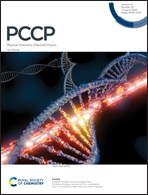Intra-octahedral distortion on lamellar potassium niobate K4Nb6O17: a periodic DFT study of structural, electronic and vibrational properties†
Abstract
Structural, electronic and spectroscopic properties of the anhydrous K4Nb6O17 niobate were investigated in the bulk phase using periodic density functional theory (DFT) calculations with global hybrid (B3LYP) and also including dispersion corrections (B3LYP-D3). The degree of native distortion of different niobium octahedra (here named [NbO6−x], or [NbO6]d) were quantified in terms of the effective coordination number (ECoN) and of other classical descriptors of local deformation and were correlated with the electronic structure. The effect of intrinsic deformation was also examined using the quantum theory of atoms in molecules and crystals (QTAIMC), density of states and charge analyses. The nature of the atom–atom interactions was classified by the ratio of the potential to the kinetic energy density at the bcp (3,−1): |V(rbcp)|/|G(rbcp)|, demonstrating that intraoctahedral Nb–O interactions are well characterized as “transit bond” (between the pure covalent and ionic chemical bonds). The vibrational spectra (infrared and Raman intensities) were fully characterized and discussed, correlating the frequencies with the intraoctahedral distortion.



 Please wait while we load your content...
Please wait while we load your content...